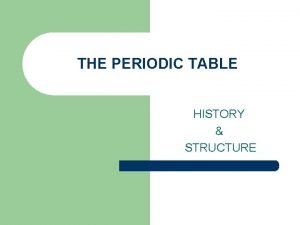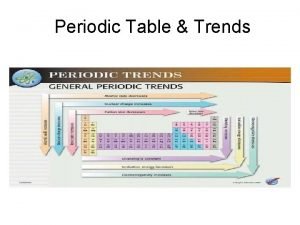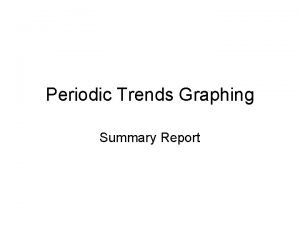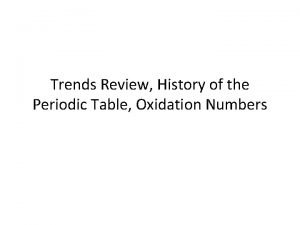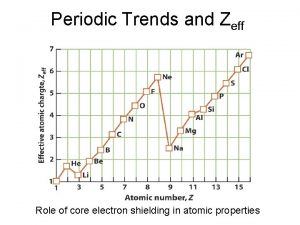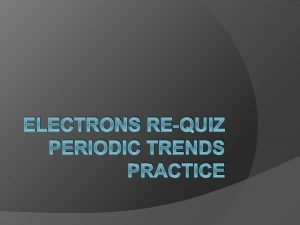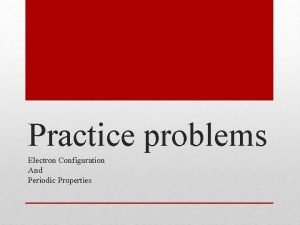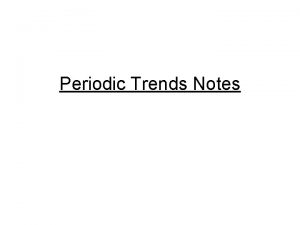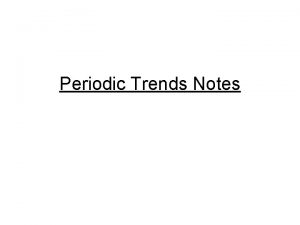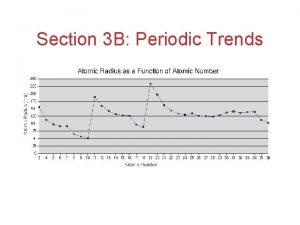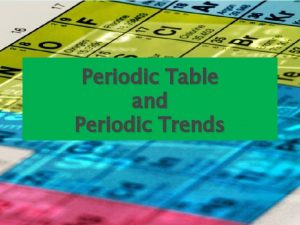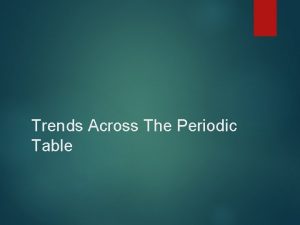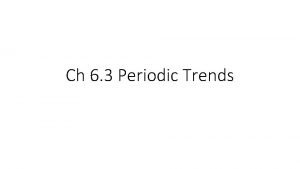Section 3 Periodic Trends Nuclear Charge Nuclear charge

















- Slides: 17

Section 3: Periodic Trends

Nuclear Charge • Nuclear charge is the pull that an electron “feels” from the nucleus. • The closer an electron is to the nucleus, the more pull it feels. • As nuclear charge increases, the electron cloud is pulled in tighter. • Increases across a period.

Shielding • As more energy levels are added to atoms, the inner layers of electrons shield the outer electrons from the nucleus. • Outer electrons are less tightly held. • Constant across a period. • Increases down a group.

Atomic Radius • Definition: Half of the distance between nuclei in covalently bonded diatomic molecule

Atomic Radius decreases across a period -due to greater nuclear charge (more protons) increases down a group -due to more shielding (more energy levels) Electronic Structure of Atoms

Atomic Radius

Example of Atomic Radius Trend • Arrange the following elements in order of increasing atomic radii: Cs, F, K, Cl

Ionic Radius Cations from metals: Anions from nonmetals: Ø e–’s lost Ø e–’s gained Ø positive (+) charge Ø negative (–) charge Ø smaller Ø larger Electronic Structure of Atoms Ø outer shell lost Ø less nuclear charge

Ions • Here is a simple way to remember which is the cation and which the anion: + This is Ann Ion. She’s unhappy and negative. + This is a cat-ion. He’s a “plussy” cat!

Cation Formation Nuclear charge on remaining electrons increases. Na atom 1 valence electron 11 p + Valence e - lost in ion formation Remaining e- are pulled in closer to the nucleus. Ionic size decreases. Result: a smaller sodium cation, Na+

Anion Formation A chloride ion is produced. It is larger than the original atom. Chlorine atom with 7 valence e 17 p + One e- is added to the outer shell. Nuclear charge is reduced and the e- cloud expands.

Ionic Radius Notice that the anions are larger than the cations!

Example of Ionic Radius Trend • Arrange the following ions in order of increasing ionic radii: Ca 2+, K+, Al 3+, S 2 -, Cl-, Te 2 -

Quick Quiz! 1. Atoms get ___ down a group due to ___. A. B. C. D. bigger, greater nuclear charge (protons) smaller, less nuclear charge (protons) bigger, more shielding (levels) smaller, less shielding (levels) Electronic Structure of Atoms

Quick Quiz. 2. Atomic radii ___ across a period due to ___. A. B. C. D. decrease, greater nuclear charge (protons) decrease, less nuclear charge (protons) increase, more shielding (levels) increase, less shielding (levels) Electronic Structure of Atoms

Quick Quiz. 3. Which of the following has the largest radius? A. Na B. Mg C. K D. Ca WHY? most shielding (levels) least nuclear charge (protons) Electronic Structure of Atoms

Quick Quiz. 4. Metals tend to ____ electrons to form _____ cations. A. gain, positive B. gain, negative C. lose, negative D. lose, positive Electronic Structure of Atoms
 Periodic table trend
Periodic table trend Periodic family names
Periodic family names Nuclear charge periodic trend
Nuclear charge periodic trend Dobereimer
Dobereimer Atomic radius periodic trend
Atomic radius periodic trend Trends in the periodic table labster
Trends in the periodic table labster Element cheat sheet
Element cheat sheet Ap chemistry chapter 7 atomic structure and periodicity
Ap chemistry chapter 7 atomic structure and periodicity Graphing periodic trends
Graphing periodic trends Oxidation trends periodic table
Oxidation trends periodic table Electronegativity meaning
Electronegativity meaning Zeff trends
Zeff trends Periodic trends activity worksheet
Periodic trends activity worksheet Periodic trends practice questions
Periodic trends practice questions Periodic trends in reactivity
Periodic trends in reactivity Summary of periodic trends
Summary of periodic trends Periodic trends practice problems
Periodic trends practice problems Coulomb's law periodic trends
Coulomb's law periodic trends



